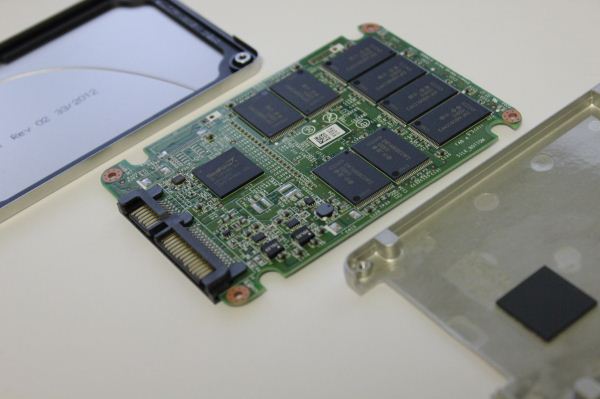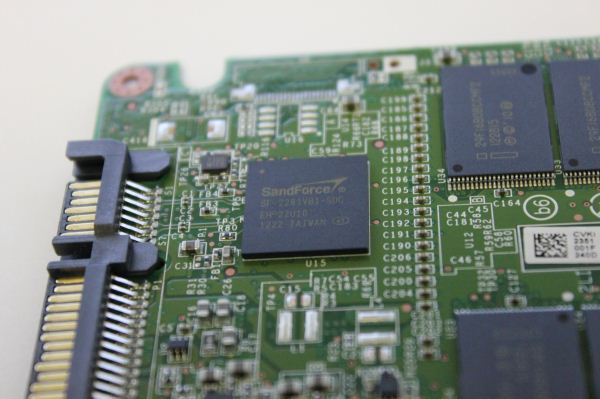Intel SSD 335 (240GB) Review
by Kristian Vättö on October 29, 2012 11:30 AM ESTInside the Intel SSD 335
Similar to the SSD 330, the SSD 335 has a single thermal pad covering the controller. The whole case is made out of metal, so heat dissipation in general should not be an issue. There doesn't seem to be any visible differences between the PCBs of SSD 335 and 330, other than the fact that the SSD 335 loses the "BIN 2" sticker and is manufactured in fab 4 instead of fab 3 (although it's completely possible that SSD 335s are manufactured in fab 3 as well).
The SF-2281
As usual, there are a total of sixteen NAND packages, eight on each side of the PCB. Each NAND package consists of two 8GB 20nm MLC NAND dies, making each NAND package 16GB in capacity. The new 20nm process node is indicated by the 12th character, which is an F. Process nodes follow the alphabet, meaning that F is 20nm, E is 25nm, D is 34nm and so on.
Test System
| CPU |
Intel Core i5-2500K running at 3.3GHz (Turbo and EIST enabled) |
| Motherboard |
AsRock Z68 Pro3 |
| Chipset |
Intel Z68 |
| Chipset Drivers |
Intel 9.1.1.1015 + Intel RST 10.2 |
| Memory | G.Skill RipjawsX DDR3-1600 2 x 4GB (9-9-9-24) |
| Video Card |
XFX AMD Radeon HD 6850 XXX (800MHz core clock; 4.2GHz GDDR5 effective) |
| Video Drivers | AMD Catalyst 10.1 |
| Desktop Resolution | 1920 x 1080 |
| OS | Windows 7 x64 |













69 Comments
View All Comments
MrSpadge - Tuesday, October 30, 2012 - link
"It is always impressive to think about performance going up with subsequent NAND generations"Well.. it might be impressive, but nevertheless it's a false assumption (if NAND generations are defined by lithography - newer interfaces could be implemented on the same lithography just as well).
Kristian Vättö - Tuesday, October 30, 2012 - link
My point was that overall performance has gone up even though the NAND is slower.mmonnin03 - Tuesday, October 30, 2012 - link
As for the comment about stocks of 25nm flash... IMFT/Micron are still making a significant amount of 25nm NAND as well as some 34nm chips.CristianM - Wednesday, October 31, 2012 - link
you wrote on average 1000 times the capacity of the disc but that does not translate in write cycles because there is the nasty write amplification which seems to be about 3 for your testcase, so there you have it. But for an average user writing 10GB per day it would take many years to wear (68) or about 7 years for writing 100G which seems unlikely for a home userCristianM - Wednesday, October 31, 2012 - link
My bad, the write amplification is taken into account, so just divide by 10 :D and the lifespan drops to 7 years for medium use and 1 year for a mad torrent user :))bankster66 - Friday, November 2, 2012 - link
Trim needs:series 7 chipset (Z77 Z78) - NOT Z68
11.5+ Intel RST OROM in bios
11.6+ Intel RST driver pak
Preferably Win 8
"RAID falls under the T10 specifications. These specs require the UNMAP command to be issued to TRIM the drive. No current Microsoft operating systems supports the UNMAP command so regardless of driver or OROM RAID arrays will not be Trimmed. Win8 will be the first MS operating system with an API in place to support the UNMAP command "
There is no way in hell you can get trim functioning with your setup, all prereqs are wrong
Per Hansson - Saturday, November 3, 2012 - link
I don't know what you are on to make an accusation like that.TRIM is supported by Windows 7
It requires the AHCI drivers in Windows to be used, or any other driver that specifically mentions that it supports TRIM.
What you are referencing is TRIM support with 2x harddrives in a RAID-0 array, and that has a long list of requirements, but how that is relevant to this Intel 335 single drive review is beyond me.
http://www.anandtech.com/show/6161/intel-brings-tr...
Bruno2 - Tuesday, March 12, 2013 - link
I noticed the following firmware update for the SSD Series 335. Perhaps this was the reason for the endurance test problems.November 2012
3.1.2
This release adds a firmware update for the Intel® SSD 335 Series fixing the following issue :
- Incorrect reporting of the E9h media wear indicator value
Bruno2 - Tuesday, March 12, 2013 - link
FYI, I noticed the following firmware update for the SSD Series 335.November 2012
3.1.2
This release adds a firmware update for the Intel® SSD 335 Series fixing the following issue :
- Incorrect reporting of the E9h media wear indicator value